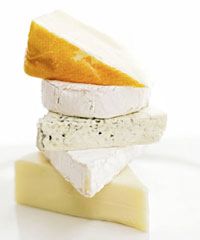Cheese Making
Cheese is way of preserving milk for long periods of time. In the process, the milk in cheese becomes something completely unlike milk, but cheese has its own interesting and delicious properties. Cheese-making is a long and involved process that makes use of bacteria, enzymes and naturally formed acids to solidify milk proteins and fat and preserve them. Once turned into cheese, milk can be stored for months or years.
The main preservatives that give cheese its longevity are salt and acids. The basic steps in cheese making go something like this (for most common cheeses like cheddar):
Advertisement
- First, milk is inoculated with lactic acid bacteria and rennet. The lactic acid bacteria convert the sugar in milk (lactose) to lactic acid. The rennet contains enzymes that modify proteins in milk. Specifically, rennet contains rennin, an enzyme that converts a common protein in milk called caseinogen into casein, which does not dissolve in water. The casein precipitates out as a gel-like substance that we see it as curd. The casein gel also captures most of the fat and calcium from the milk. So the lactic acid and the rennet cause the milk to curdle, separating into curds (the milk solids, fats, proteins, etc.) and whey (mostly water). A gallon of milk (about 8 pounds) yields only about 1.25 pounds of cheese -- the weight that is lost is all the water in milk.
- The curds and whey are allowed to soak until the lactic acid bacteria create a lactic acid concentration that is just right. At that point, the whey is drained off and salt is added.
- Now the curds are pressed in a cheese press -- lightly at first to allow the escape of the remaining whey, then severely (up to a ton of pressure) to solidify the cheese.
- Finally, the cheese is allowed to age (ripen) for several months in a cool place to improve its taste and consistency. A sharp cheddar cheese has been aged a year or more. During this time, enzymes and bacteria continue to modify proteins, fats and sugars in the cheese. The holes in Swiss cheese occur during ripening -- Swiss cheese is ripened in a cool place for several weeks, then put in a warm place (70 degrees F, 21 degrees C or so) for four to six weeks, where special bacteria ferment the remaining lactose and produce carbon dioxide bubbles in the cheese.
As you can see, cheese-making is complicated. It produces a product that preserves milk proteins and sugars with acids and salt.
